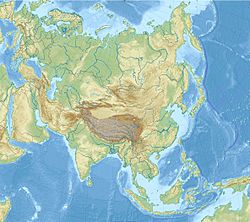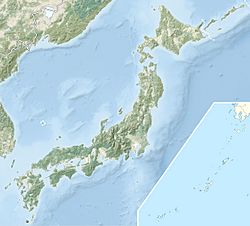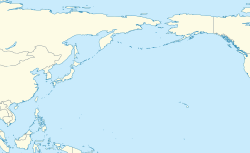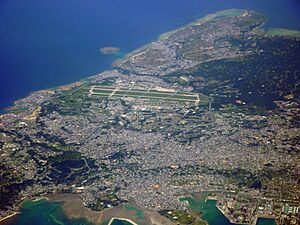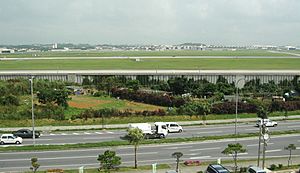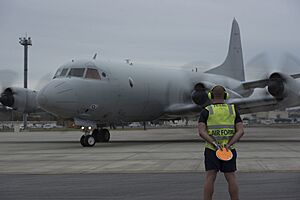Kadena Air Base facts for kids
Quick facts for kids Kadena Air Base |
|||||||||
|---|---|---|---|---|---|---|---|---|---|
| 嘉手納飛行場 Kadena Hikōjō |
|||||||||
| Kadena, Okinawa Prefecture in Japan | |||||||||

A U.S. Air Force E-3 Sentry from the 961st Airborne Air Control Squadron taxis on the runway before take-off from Kadena Air Base in 2015.
|
|||||||||
 |
|||||||||
| Coordinates | 26°21′06″N 127°46′10″E / 26.35167°N 127.76944°E | ||||||||
| Type | U.S. Air Force Base | ||||||||
| Site information | |||||||||
| Owner | Various (leased by Government of Japan and made available to the U.S.) | ||||||||
| Operator | U.S. Air Force | ||||||||
| Controlled by | Pacific Air Forces (PACAF) | ||||||||
| Status | Operational | ||||||||
| Site history | |||||||||
| Built | 1945 (as Yara Hikojo Airfield) | ||||||||
| In use | 1945 – present | ||||||||
| Garrison information | |||||||||
| Current commander |
Brig. Gen. David Eaglin | ||||||||
| Garrison | 18th Wing (Host) | ||||||||
| Airfield information | |||||||||
| Identifiers | IATA: DNA, ICAO: RODN, WMO: 479310 | ||||||||
| Elevation | 43.6 metres (143 ft) AMSL | ||||||||
|
|||||||||
| Other airfield facilities |
1x V/STOL pad | ||||||||
Kadena Air Base (嘉手納飛行場, Kadena Hikōjō) is a very important United States Air Force base located in Okinawa Prefecture, Japan. It's often called the "Keystone of the Pacific" because of its key location. The base is about 650 km (400 mi) from China and 770 km (480 mi) from Shanghai, a big city in China.
Kadena Air Base is home to the U.S. Air Force's 18th Wing, the 353rd Special Operations Wing, and other important units. More than 20,000 American service members, their families, and Japanese employees live or work here. It is the largest and busiest U.S. Air Force base in East Asia.
Contents
History of Kadena Air Base
Kadena Air Base began its history just before the Battle of Okinawa in April 1945. A local company finished building a small airfield called Yara Hikojo near Kadena village. This airfield was used by the Imperial Japanese Army Air Force. It was one of the first places targeted by the Tenth United States Army during the battle. The United States took control of it from the Japanese.
World War II and Early Operations
When the Americans took over, the airfield had a 4,600 feet (1,400 m) long coral runway that was badly damaged. U.S. Army engineers quickly started repairs on April 4, 1945. By the end of that day, the runway was ready for emergency landings. Just eight days later, after more work, the airfield was fully open. It was immediately used by planes that helped spot artillery targets. More construction followed, adding new runways for fighter and bomber planes by August.
Kadena airfield was first managed by the Seventh Air Force. Later, in July 1945, the headquarters of the Eighth Air Force moved to a nearby town. Its mission was to train new B-29 Superfortress bomber groups for missions against Japan. However, the atomic bombings led to Japan's surrender before the Eighth Air Force saw combat in the Pacific theater.
Japanese forces in the Ryukyu Islands surrendered on September 7, 1945. General Joseph Stilwell accepted the surrender in an area that is now part of Kadena's housing.
Some of the U.S. Air Force units stationed at Kadena during and right after World War II included:
- 319th Bombardment Group (Light) (July–November 1945): Flew missions over Japan and China.
- 317th Troop Carrier Group (August–September 1945): Transported people and supplies.
- 333d Bombardment Group (Very Heavy) (August 1945 – May 1946): Prepared for the invasion of Japan. After the war, they helped transport Allied prisoners of war.
- 346th Bombardment Group (Very Heavy) (August 1945 – June 1946): Also prepared for the invasion and later transported prisoners of war.
- 413th Fighter Group (November 1945 – October 1946): Provided air defense for the Ryukyu Islands.
In June 1946, the 1st Air Division took over command. It managed fighter, reconnaissance, and bomber units, and provided air defense for the Ryukyu Islands until December 1948. The Twentieth Air Force became the main command for Kadena in May 1949.
Korean War Era
The Korean War (1950-1953) showed how important it was to have a naval presence on Okinawa. In 1951, the U.S. Naval Facility, Naha, was opened. Later, in 1975, naval operations moved to Kadena Air Base.
The Twentieth Air Force was deactivated in March 1955. The Fifth Air Force then became the main command for Kadena. During the Korean War, several bomber units were stationed at Kadena and flew combat missions over Korea:
- 19th Bombardment Group (Medium) (July 1950 – May 1954): Flew combat missions over Korea.
- 22d Bombardment Group (Medium) (July 1950 – October 1950): Also flew combat missions over Korea.
- 307th Bombardment Group (Medium) (September 1950 – February 1951): Received awards for its air strikes in Korea.
The 18th Wing
On November 1, 1954, the 18th Fighter-Bomber Wing arrived at Kadena. This wing, with different names over the years, has been the main U.S. Air Force flying unit at Kadena for more than 50 years. It keeps aircraft, crews, and support staff ready for missions. The wing first flew North American F-86 Sabre jets. In 1957, they upgraded to F-100 Super Sabre jets. In 1960, they added reconnaissance (scouting) missions with McDonnell F-101 Voodoo planes.
Vietnam War Period
Starting in 1961, the 18th Wing sent its squadrons to South Vietnam and Thailand. They supported U.S. Air Force combat missions in the Vietnam War. In 1963, the F-105 Thunderchief jets replaced the Super Sabres. The wing's planes flew many missions during the war.
The RF-4C Phantom II jets took over the reconnaissance role in 1967. In 1968, the wing also added electronic warfare capabilities with EB-66 Destroyer planes. These planes flew daily over Southeast Asia until 1970.
During the 1968 Pueblo crisis, the 18th Wing sent planes to South Korea. Since then, they have often deployed to South Korea to help with air defense.
After Vietnam
The F-4 Phantom II jets replaced the F-105s in 1971. In 1979, the wing upgraded again to the F-15 Eagle.
On November 6, 1972, the 18th Wing sent its F-4 Phantom II fighter jets to Ching Chuan Kang Air Base, Taiwan. They helped Taiwan's air defense against threats from China until May 1975.
On October 1, 1991, the wing's name changed to the 18th Wing. Its mission expanded to include many different types of aircraft and roles. This included aerial refueling with KC-135 Stratotanker planes, and surveillance, warning, command, and control with E-3 Sentry planes. In June 1992, they added an airlift mission using C-12 Huron planes to transport important people and cargo. In February 1993, the 18th Wing also became responsible for coordinating rescue operations in the Western Pacific and Indian Ocean.
Patriot Missile Unit
In November 2006, the U.S. Army's 1st Battalion, 1st Air Defense Artillery Regiment, which uses Patriot PAC-III missiles, moved to Kadena. This unit's job is to defend the base from tactical ballistic missiles, especially from North Korea. This move was part of agreements between the U.S. and Japan.
Future Plans for F-15EX Jets
In late 2023, there were reports that the U.S. Air Force might permanently station Boeing F-15EX Eagle II jets at Kadena Air Base. This would be a change from the 48 F-15C Eagle jets that were there before.
Other Countries' Units
Other U.S. allies have also shown interest in having units at Kadena Air Base. This helps them work together against regional threats, like those from North Korea and China.
Australia and New Zealand
In September 2018, Australia and New Zealand said they wanted to help Japan and the United States. They sent patrol aircraft to help prevent North Korean ships from illegal trading, which breaks UN rules. The Royal Australian Air Force sent two AP-3C aircraft, and the RNZAF sent a P-3K2 Orion. Australian P-8 Poseidons and RNZAF Orions continue to operate from Kadena sometimes.
Other Important Units
Many other important units have been assigned to Kadena since 1954:
- 313th Air Division (March 1955 – October 1991): Responsible for air defense and tactical operations in the Far East.
- 498th Tactical Missile Group (February 1961 – October 1969): Used Mace guided cruise missiles.
- 376th Strategic Wing (April 1970 – August 1973): Flew B-52 combat missions in Southeast Asia.
- 9th Strategic Reconnaissance Wing (SAC) (1968–1974): Flew SR-71 reconnaissance (spy) missions over North Vietnam and Laos. The SR-71s were nicknamed "Habu" by the Okinawans because they looked like a local snake. The SR-71 missions from Okinawa ended in 1990.
What Kadena Air Base Does
The 18th Wing is the main unit at Kadena Air Base. The base also hosts units from other Air Force commands, the United States Navy, and other Department of Defense groups. These units operate more than 20 planes daily.
The 18th Wing's Role
The 18th Wing is the Air Force's largest and most varied combat wing. It has five main groups:
- 18th Operations Group: Manages flying missions.
- 18th Maintenance Group: Keeps the planes in good working order.
- 18th Mission Support Group: Provides support services for the base.
- 18th Civil Engineer Group: Handles construction and base infrastructure.
- 18th Medical Group: Provides medical care.
Kadena's planes include:
- F-15C/D Eagle fighter jets (from the 44th and 67th Fighter Squadrons).
- KC-135R/T Stratotanker refueling planes (from the 909th Air Refueling Squadron).
- E-3B/C Sentry command and control planes (from the 961st Airborne Air Control Squadron).
- HH-60 Pave Hawk rescue helicopters (from the 33rd Rescue Squadron).
353rd Special Operations Wing
The 353rd Special Operations Wing is part of the Air Force Special Operations Command. Its 750 Airmen fly specialized planes like the MC-130J Commando II and the CV-22B Osprey. They are trained for special missions.
733rd Air Mobility Squadron
The 733rd Air Mobility Squadron manages all air travel for people and cargo at Kadena. This unit supports about 650 planes arriving and departing each month. They move over 12,000 passengers and nearly 3,000 tons of cargo.
82nd Reconnaissance Squadron
The 82nd Reconnaissance Squadron maintains aircraft and trains crews for reconnaissance missions. They gather and share important intelligence data. They fly RC-135V/W Rivet Joint, RC-135U Combat Sent, and WC-135 Constant Phoenix planes in the Pacific.
390th Intelligence Squadron
This squadron gathers and analyzes intelligence information. They help improve warfighting and targeting by understanding enemy systems and protecting friendly ones.
U.S. Army Units
The U.S. Army's 1st Battalion, 1st Air Defense Artillery Regiment is a Patriot missile unit. It has four Patriot missile batteries and other support companies.
Housing Management Office
The Air Force Housing Management Office manages housing for all service members and their families on Okinawa. Kadena Air Base has almost 4,000 family housing units, including apartments, townhouses, and single-family homes.
Other Units and Services
Kadena Air Base also hosts many other important units and services, such as:
- American Forces Network (AFN): Provides news and entertainment.
- Various support centers and offices for logistics and security.
- Defense Commissary Agency: A grocery store for military families.
- Department of Defense Education Activity (DoDEA) schools:
- Bob Hope Elementary School
- Kadena Elementary School
- Ralph F. Stearley Primary School
- Amelia Earhart Intermediate School
- Kadena Middle School
- Ryukyu Middle School
- Kadena High School
- American Red Cross: Provides support services.
Based Units
Here are some of the main flying and non-flying units based at Kadena Air Base:
United States Air Force
|
Pacific Air Forces (PACAF)
|
Air Force Special Operations Command (AFSOC)
Air Mobility Command (AMC)
Air Combat Command (ACC)
* Detachment 1 (GSU) Civil Air Patrol (CAP)
United States ArmyU.S. Army Pacific (USARPAC)
United States Marine CorpsMarine Forces Pacific (MARFORPAC)
|
Environmental Concerns
In June 2013, the Japanese government found old barrels buried on land that used to be part of the base. Tests showed these barrels had contained chemicals like dioxins and herbicides. The levels of dioxin in the soil and groundwater nearby were much higher than allowed. This area was a soccer field next to a school for kids on base. There were concerns about the chemicals being so close to the school. U.S. Air Force officials later tested the soil and water at the schools and stated that no excessive toxic substances were found there.
Accidents and Incidents
- June 30, 1959: An F-100 jet from the wing crashed on Okinawa during a training flight. The pilot safely ejected, but the plane hit a local elementary school. This tragic accident killed 11 students and 6 other people, and injured 210.
- November 19, 1968: A B-52 bomber broke apart and caught fire after trying to take off for a bombing mission. Two crew members died.
- July 20, 1972: An SR-71 spy plane went off the runway while landing during strong winds from Typhoon Rita. The plane was badly damaged, but both crew members were safe.
- November 2, 1987: An RF-4C plane crashed into the ocean. Both crew members ejected, but one was never found.
- May 28, 2013: An F-15C jet from the 44th Fighter Squadron crashed into the ocean near Okinawa. The pilot ejected and was rescued by the Japan Air Self-Defense Force.
- June 11, 2018: Another F-15C from the 44th Fighter Squadron crashed into the sea off Okinawa. The pilot was rescued by the Japan Air Self-Defense Force.
See also
 In Spanish: Base Aérea de Kadena para niños
In Spanish: Base Aérea de Kadena para niños
- Naval Base Okinawa


